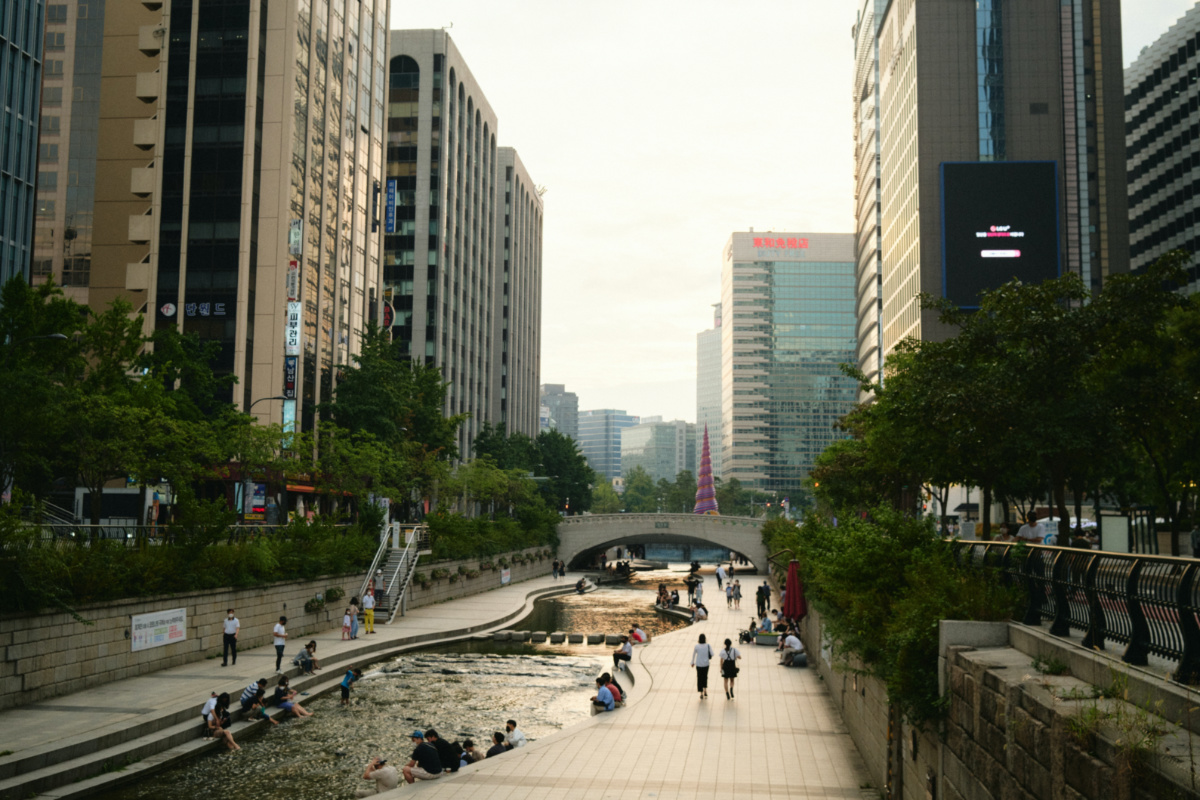Barcelona, Spain
Thomson Reuters Foundation
After a landslide in 2017 killed 1,141 people and left more than 3,000 homeless in Sierra Leone’s capital Freetown, the recovery plan included training residents to plant 21,000 native trees to reduce the risk of future disasters on bare hillsides.
Amid erratic and unusually heavy rains, as well as urban expansion, the city’s mayor has also run a “Freetown the Treetown” campaign to increase green cover 50 per cent by the end of 2022, with locals tracking tree growth via a smartphone app.
In South Korea’s Seoul, meanwhile, the city government worked with residents to restore the Cheonggyecheon Stream, a river covered by a highway overpass for decades.
The nature revival project, carried out in the early 2000s, has lowered traffic, flooding and temperatures, stimulated nearly $US2 billion in urban redevelopment and attracts 64,000 visitors a day.

The Cheonggyecheon Stream in downtown Seoul. PICTURE: Yeoul Shin/Unsplash.
Such examples suggest why cities worldwide should invest more in expanding green spaces and nurturing natural systems that provide water, food and clean air – not just to keep residents healthy and tackle climate-change risks but to boost their economies, researchers said on Monday.
Yet despite the benefits of green urban improvements, little money is spent on them, they said in a report released by the BiodiverCities by 2030 initiative.
That effort to green cities is led by the World Economic Forum, the Alexander von Humboldt Biological Resources Research Institute in Bogota and the Colombian Government.
Cities invest no more than 0.3 per cent of their infrastructure spending in so-called “nature-based solutions” – or only about $US28 billion in 2021, researchers said, calling for that to rise.
GDP at risk
Akanksha Khatri, WEF’s head of nature and biodiversity, said the conventional view that urban development and a healthy environment are at odds no longer holds.
“Nature can be the backbone of urban development,” she said in a statement. “By recognising cities as living systems, we can support conditions for the health of people, planet and economy in urban areas.”
The report warned that if cities fail to protect their natural habitats, 44 per cent of their gross domestic product – or $US31 trillion globally – is at risk.
That could be from floods – identified as the most common natural risk across more than 1,600 cities with over 300,000 inhabitants – due to problems such as loss of coastal mangroves that keep storm surges at bay or waste-clogged rivers, it said.
Other major threats from climate and nature damage include drought – with one in four cities already water-stressed – fiercer heatwaves, and water and air pollution which take a toll on human health.
The resulting economic losses could be averted by investing a larger slice of stretched municipal budgets in “green infrastructure” like parks, street trees, lakes, wetland areas and roofs with gardens.
Spending $US583 billion a year by 2030 on such solutions and projects that free up city land for nature could create more than 59 million jobs, including 21 million dedicated to restoring and protecting natural ecosystems, the report noted.
Nature-based solutions are on average 50 per cent more cost-effective than man-made, concrete-heavy options such as roads, buildings and paved areas, it found.
We rely on our readers to fund Sight's work - become a financial supporter today!
For more information, head to our Subscriber's page.
Breaking down barriers
Robert McDonald, a scientist with The Nature Conservancy and a member of the BiodiverCities global commission, said just doubling spending on green infrastructure – which would still account for only a tiny share of municipal projects – would be “transformative for how a lot of cities feel to live in”.
Yet the traditional option of building concrete infrastructure still tends to win out, partly due to silos between city departments, he told the Thomson Reuters Foundation.
Reaping the full benefits of expanding urban nature will require working across municipal governments, as well as with companies and citizens, he added.
The advantages of nature-based solutions, like planting trees to shade and cool streets, are starting to become evident as climate change bites in the form of threats such as worsening heatwaves that hit city dwellers hardest, McDonald noted.
That is driving broader recognition of the value of investing in nature, he said.
“Even folks who really want to think about dollars and cents are realising that link,” he said.





